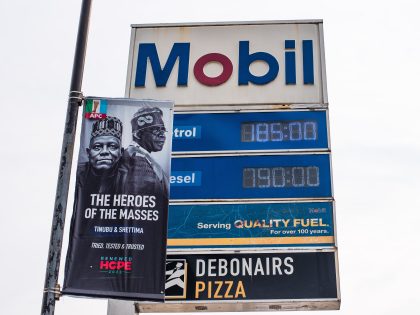Africa, in a state of constant self-discovery
Afripedia is a visual guide to contemporary urban culture on the continent.

Teddy Goitom, Swedish-Ethiopian/Eritrean content producer believes that “… when Africa is changing, when the world is changing and the perspective is shifting, the image of Africa and Africans needs to change too.” Goitom is founder of Stocktown, a “cultural movement” whose mission is to document urban culture throughout the world via their online video magazine and through their production company, Stocktown Films. Over the past few years they have spent a lot of time traveling across Africa, profiling artists for their ongoing Afripedia documentary project. Afripedia seeks to be a visual guide to contemporary urban culture on the continent. Each half hour documentary film presents an Africa that is hip and new, in a state of constant self-discovery. The characters featured are well chosen and could have each been the subject of their own documentary. However, as “outsiders” (Goitom is sorta both) are Stocktown Films able to capture these cultural scenes authentically? We got a few of our resident contributors to review the Afripedia documentary shot in the countries they call home.
Ghana—Wanlov The Kubolor: I am sad because I just watched a powerful and inspiring documentary that the majority of the youth in Ghana will never get to see; as fast, steady and affordable internet access is still a privilege here. The new generation of Ghanaian artists in various disciplines that intrigue me have been represented in this documentary. This may merely be an exciting, well-made documentary to many, but to the Ghanaian youth this is a very needed artistic boost and needs to be shown on all Ghanaian TV networks.
Serge Attukwei Clottey is an artist making art out of his polluted environment. Abrokwah, Computer Man & Black Fire are street boys who have managed to become the most sought after bicycle circus. Jojo Abot the afro funky singer/fashionista recycles old clothes into chic vintage fashion. And Noella Wiyaala an unannounced feminist singer/performer comes across as a Angelique Kidjo/ Grace Jones hybrid. All these artists are somehow linked to the Professor Xavier & Jean Grae of Ghana’s alternative creative scene, namely Mantse Aryeequaye & Dr. Sionne Neely of ACCRA dot ALT, Talk Party Series, Sabolai Radio & Chalewote Street Festival.
I must point out that I was not totally sold on Noella till I watched this documentary and heard her back-story as tears streamed down her resilient cheeks. Much respect to Stocktown for this very relevant contribution.
Angola—Marissa Moorman: Stocktown’s deft work brings a welcome focus to some of Angola’s most compelling and challenging young talent: Nástio Mosquito, Titica, and MC Sacerdote’s crew and collaborators at Circuito Fechado. Their conditions of production couldn’t be more different, as we see in this short film. And Mosquito is a charming guide full of biting critiques and insights. I love the clarity of the shots and the sense of being in the space with the artists. But that sense of transparency and the limitless possibilities of technology to connect us across and despite borders, languages, and politics bothers me too. What this short fails to show us is how difficult it is to do precisely this kind of production in Angola unless you are well connected. Nástio Mosquito and the producers of Geração 80 are the children of elites. While their work often cuts against the virulent accumulation and divisions of those elites, their connections grease the wheels of bureaucracy and make the work of Stocktown possible. Seeing the whole apparatus of cinematic production would open up the complex workings of music and artistic production in Angola.
Kenya—Philippa Ndisi-Herrmann: What happens, when our father, concerned with other affairs leaves us in our bedroom with a cocktail of passion, toys and dreams?
We create; for our pleasure and then we transmit our creations to the outer space of the World Wide Web. Perhaps if we hadn’t glimpsed the domestic terror of post-election violence, we would not have retreated to the comfort of our mind’s bedroom. You don’t need Dad to travel there, nor coins for a bus ticket. Now we have returned home, bearing souvenirs from the farthest reaches of our imagination, “I didn’t know they make stuff like this in Africa,” is the demonstrative response.
Featuring Bob Muchiri, Just-a-Band, and Andrew Kaggia and other young ambassadors of creative cool, Afripedia Kenya highlights curious and impressive works that tickle stereotypes.
How refreshing to see exciting work from where you are from. Creating art about ourselves is like a surprise glimpse of our reflection, “Wow, is that me? How brilliant and strong I am, is that a pot belly, perhaps I need to work on that!” So yes, we create to double take, reflect and regroup our troops, how far have we come, where are we going, are we learning something new about ourselves? Whatever the answer, it does not matter, as long as we keep along this path, reaching and pushing, because now the creation is beyond our bedroom. May we remember our bedroom beginnings; we created such work independent of our father, with no fear to express our thoughts and feelings and in this same way, may we continue.
South Africa— Mpho Moshe Matheolane: The beginning of the documentary introduces Xander Ferreira and Nick Matthews AKA DJ Invizable (of electro group Gazelle) standing on the beach in Clifton, Cape Town. They are dressed in their usual eccentric performance attire and talk animatedly about their work. The documentary, with this introduction, hints at its subject – the wave of unbridled creativity that surges through a young democratic South Africa.
It also subtly hints at the seemingly unchanged reality of things as well as the confusion that permeates this young democratic country dealing with its “new” freedom and identity issues. Ferreira is the perfect example of this cultural landscape – a white musician, trying to create something new and yet borrowing to create his aesthetic approach, which looks like a concoction of black popular and African cultural imagery. Immediately one asks, what is he selling?
But this is merely one part of the documentary. In Gauteng, young black musicians pursue what would be considered an unconventional and white sound in the form of hard rock. Strange as it appears, it is a sound whose influence goes far back in South African music history, groovy black rockers illustrating that rock is a genre that refuses exclusivity, not even in the township. Indeed, the township is alive with youngsters who see themselves as more than what their circumstances dictate. A young photographer, Musa N. Nxumalo, captures its scene. Enter the Smarteez. Fashion-Afro-futurists, not so much because they are reinventing the wheel but rather because they are infusing their unique sense of identity into what they create. Out of the confusion that dogs South Africa some are forging new ways of being seen, and go figure, it is the youth. Back in Cape Town, in a location other than Clifton beach, a rap duo with a love for arcade games, Die Getuies, makes music that expresses their joyful obsession. There is meaning in all of this. As Ferreira says at one point, “you’ve got to do something for yourself or do something yourself” – that’s fitting – it’s exactly what the documentary captures.
Senegal—Ricci Shryock: The film opens by spotlighting some of Senegal’s most thriving and well-known artists, such as photographer Omar Viktor Diop and Selly Raby Kane. I was glad to see Ken Aicha Sy, a cultural activist and blogger, featured as she’s an integral part of the scene here in Dakar and dedicates herself consistently to promoting both the bigger talents and the lesser-known, underground artists. The cinematography was lovely and did a fantastic job of showing off the beautiful spots of Dakar. What I find especially cool about Senegal’s arts and culture is that the artists integrate the newest styles of hip-hop, fashion, etc. with traditional Senegalese style in such an innovative way. This film captured that well – whether it was showing off Diop’s unique photographic process or Khoudia Toure‘s dance circle that showcased both b-boy and Sabar dancers. I would add I didn’t like the use of subtitles. The artists who spoke English expressed themselves perfectly well enough to not need the text. It not only distracted from the great visuals but I also found it condescending to the artists to imply their English wasn’t understandable. All in all though, a great mini-doc that shows a slice of Dakar not always recognized on the global scene.
- Stocktown is currently working on compiling Afripedia into a full length documentary film. Until then, follow them on their tumblr and check out Afripedia.com.



















